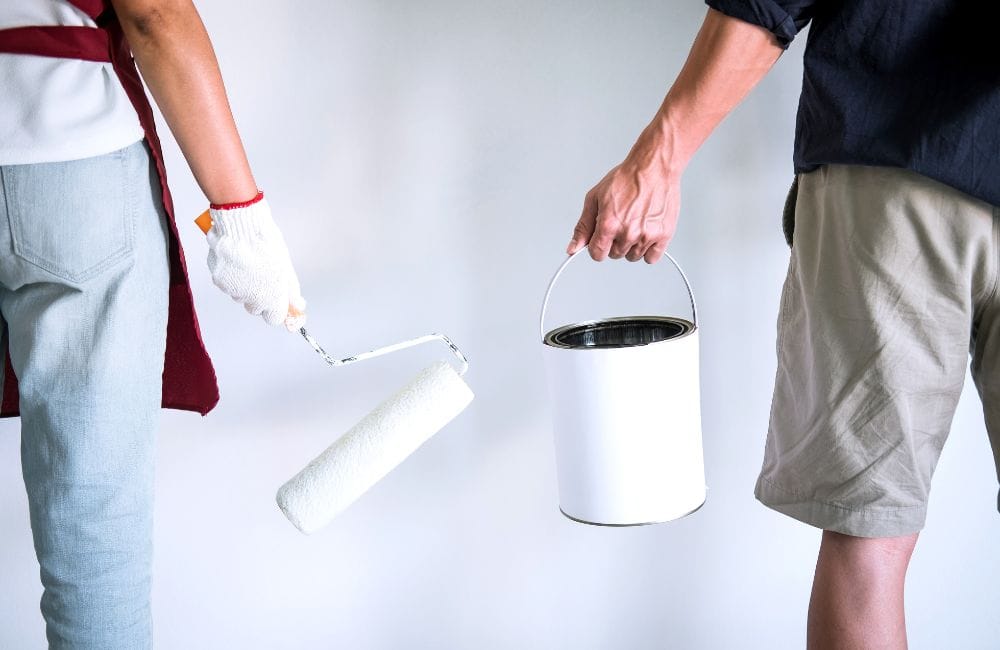Menu

Key Takeaways
6 Tips for a Seamless Experience with Your Painting Contractor
1. Research and Choose Wisely
2. Clearly Define Your Project
3. Get Detailed Estimates
4. Check for Licensing and Insurance
5. Establish a Timeline
6. Prepare Your Home
Frequently Asked Questions
Transform Your Home with Our Expert Painting Services!
✔ Conduct thorough research and select a reputable contractor.
✔ Clearly outline your project’s scope and specific details.
✔ Request and compare itemized estimates from multiple contractors.
✔ Verify the contractor’s licensing and insurance credentials.
✔ Set a realistic timeline and discuss potential delays.
✔ Prepare your home by moving furniture and ensuring necessary access.
About 42%of U.S. homeowners who renovated their homes in 2023 used the help of a construction professional, highlighting the importance of hiring skilled experts for home projects. To ensure your painting project goes smoothly, careful planning and clear communication with your painting contractor are crucial.

Ensuring a smooth and seamless experience with your painting contractor in West Hartford, CT, requires careful planning and communication. Here are six essential tips to help you achieve the best results:
Choosing the right painting contractors for your project is crucial for ensuring a smooth and successful experience. The first step in this process is conducting thorough research. This involves gathering as much information as possible about potential painting contractors in your area.
Conducting thorough research is essential to ensure you choose the right painting contractors for your project. Here are some effective ways to gather the information you need:
Once you have a list of potential painting contractors, the next step is to verify their credibility through references and reviews. This step is vital to ensure that the painting contractors you are considering have a history of delivering quality work and customer satisfaction.
When working with painting contractors, it’s crucial to have a well-defined project plan to ensure everything goes smoothly. This involves several key steps that will help you and your contractor stay on the same page and achieve the desired outcome.
Before you hire painting contractors, it’s essential to clearly specify the scope of work. This includes:
Choosing your colors and finishes before the project begins is vital for a smooth experience with painting contractors. Here’s how to do it:
Effective communication with your painting contractors is key to a successful project. Here are some tips:
When working with painting contractors, obtaining detailed estimates is crucial to ensure you receive the best value for your investment. Here are essential steps to follow:
One of the first steps in getting a detailed estimate is to request itemized quotes from your painting contractors. An itemized quote breaks down the cost of each aspect of the job, providing transparency and clarity. Here’s what an itemized quote should include:
It’s not enough to just have an itemized quote; you need to understand the cost breakdown provided by your painting contractors. This involves examining each component of the quote and asking questions where necessary. Key areas to scrutinize include:
Once you have detailed, itemized quotes from several painting contractors, the next step is to compare them to find the best value. Here are some tips for comparing estimates:

When hiring painting contractors, ensuring they are properly licensed and insured is crucial. This step protects you from potential liabilities and guarantees a level of professionalism and competence.. Here’s how to ensure your painting contractors meet these essential criteria:
A valid license is a sign that the painting contractors have met the required standards and are authorized to perform their work in your area. Here’s how you can verify this:
Insurance coverage is essential for protecting both you and the painting contractors from potential accidents and damages. Make sure the painting contractors have the following insurance types:
Hiring painting contractors who lack the necessary licenses and insurance can lead to significant problems. Consider the following risks:
One of the most crucial aspects of working with painting contractors is establishing a timeline. A clear and realistic project schedule ensures that both you and the contractor are on the same page, reducing the likelihood of misunderstandings and delays.
When planning your painting project, it’s important to set a realistic schedule. Discuss with your painting contractors about how long each phase of the project will take. Here are some key points to consider:
Even with a well-planned schedule, unforeseen delays can occur. It’s essential to discuss potential delays and contingencies with your painting contractors. Common causes of delays include:
To avoid scheduling conflicts, it’s crucial to ensure your painting contractors’ availability aligns with your desired timeline. Discuss the following with your contractors:
When working with painting contractors, preparing your home properly is crucial to ensure a smooth and efficient process. Here are some steps to take:
Before the painting contractors arrive, it’s essential to move furniture and valuables out of the way. This step not only protects your belongings but also provides a clear workspace for the contractors.
Effective communication with your painting contractors about prep work and clean-up is key to a smooth experience. Clarifying these details upfront can prevent misunderstandings and ensure the project runs efficiently.
Providing the painting contractors with easy access to all necessary areas is essential for maintaining the project’s momentum. Here’s how to ensure everything is accessible:
The type of paint you choose is crucial for achieving the desired look and durability. The contractor should recommend paint based on several factors, such as durability, finish, and color preference. High-traffic areas, like hallways and kitchens, might benefit from more durable, washable paints. Paint finishes range from matte to high gloss. Matte finishes are great for hiding imperfections, while glossier finishes are easier to clean and more reflective. Choose a color that complements your decor and meets your aesthetic goals. Some paints also offer features like low VOC (volatile organic compounds) for better indoor air quality.
The duration of a painting project varies depending on several factors, including the project size and complexity. Larger projects naturally take more time. Painting an entire house will take significantly longer than a single room. Projects with intricate details, multiple colors, or extensive prep work (like repairing walls or removing wallpaper) will extend the timeline. For exterior painting, weather conditions can significantly affect the schedule, as rain or high humidity can delay the project.
Proper maintenance can extend the life and appearance of your painted surfaces. To clean walls, use a soft cloth or sponge with mild soap and water. Avoid harsh chemicals that can damage the paint. Keep some leftover paint for touch-ups, as small chips and scratches can be easily repaired to maintain a fresh look. Use furniture pads to prevent scuffs, and be mindful of moisture, especially in areas like bathrooms and kitchens, to prevent mold or mildew.
While it’s not always necessary to be home during the painting process, it can be beneficial. Being available can help address any questions or decisions that arise during the project, such as unexpected repairs or color adjustments. You can keep an eye on the progress and ensure that everything is going according to plan. Additionally, you might need to provide access to different areas of your home, which is easier if you’re present.
Selecting the right paint color involves considering several elements like lighting, room size, and mood. Natural and artificial lighting can affect how a color looks in a room. Test samples in different lighting conditions to see how they change. Lighter colors can make a small room feel larger, while darker colors can create a cozy, intimate atmosphere. Different colors evoke different moods; for instance, blues and greens are calming, making them ideal for bedrooms, while vibrant colors like reds and yellows can energize a space.
Looking for top-notch painting services in West Hartford, CT? Look no further than West Hartford House Painting Experts! We are committed to transforming your home with professional, high-quality painting services. Our experienced team in West Hartford, CT, is dedicated to ensuring your satisfaction with every project. Trust West Hartford House Painting Experts to bring a fresh, vibrant look to your home in West Hartford, CT. Contact us today to schedule your consultation!

Welcome to West Hartford House Painting Experts. We believe that we are the highest quality painting company in this community and we provide excellent customer service!